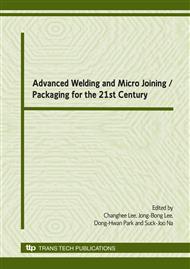p.167
p.173
p.177
p.183
p.191
p.197
p.201
p.205
p.209
Effect of Laser Parameter on the Bond Characteristics of Sn-3.5%Ag Solder Ball
Abstract:
Pulsed Nd;YAG laser was applied to investigate the bond characteristics of Sn- 3.5wt%Ag (hereafter, Sn-3.5Ag) solder ball. The ball diameter is 500µm, and the UBM (Under Bump Metallurgy) on a FR4-PCB consisted of Cu/Ni/Au from bottom to top with thickness of 50µm/25µm/0.05µm, respectively. A RMA (rosin mildly activated) flux for BGA (Ball Grid Array) was applied before laser soldering to set up the solder ball on the UBM. Laser power was 250W, and its beam diameter at the focal point was around 250µm. Experimental results reveal that the solder ball showed a good bonded state when the laser energy was in the range between 0.8 and 1.0 J. Laser energy lower than 0.8J caused non-wetting of the solder ball, and energy higher than 1.2J showed crack along the UBM. Microstructure of the laser soldered Sn-3.5Ag was examined with the number of pulse, when the frequency, pulse width and laser energy were fixed at 5 Hz, 20 ms and 0.8 J, respectively. The IMC (Intermetallic Compound) of Ag3Sn in the solder changed from acicular to rod type with increasing laser pulses. Ni3Sn4 was produced between the solder and the UBM, and its thickness increased from 0.65 to 1.80µm with increasing number of pulse from 2 to 4. These are thinner than those of general air reflow. Shear strength of the laser soldered ball with output energy of 1 J showed 652.3 gf, and it was similar value compared to the result from hot plate soldering, 654.5 gf.
Info:
Periodical:
Pages:
191-196
Citation:
Online since:
June 2008
Authors:
Keywords:
Price:
Сopyright:
© 2008 Trans Tech Publications Ltd. All Rights Reserved
Share:
Citation:


